Auditing Report: Evidence, Ratios, Controls, and Audit Procedures
VerifiedAdded on 2023/01/06
|10
|3018
|73
Report
AI Summary
This comprehensive auditing report delves into various aspects of the auditing process. It begins with an introduction to auditing and its importance, followed by an examination of sufficient and appropriate audit evidence, including a discussion of its definition and application in specific scenarios. The report then analyzes financial ratios, providing explanations for their results and implications. Furthermore, it identifies and explains internal control weaknesses within a given company, discussing the potential consequences of these weaknesses. The report also evaluates an auditor's conclusion in a given case, justifying the answer by addressing related party transactions and reliability. Finally, the report outlines audit procedures for revenue verification and provides insights into the features of both internal and external auditors, including their independence and roles within internal control and operational systems.
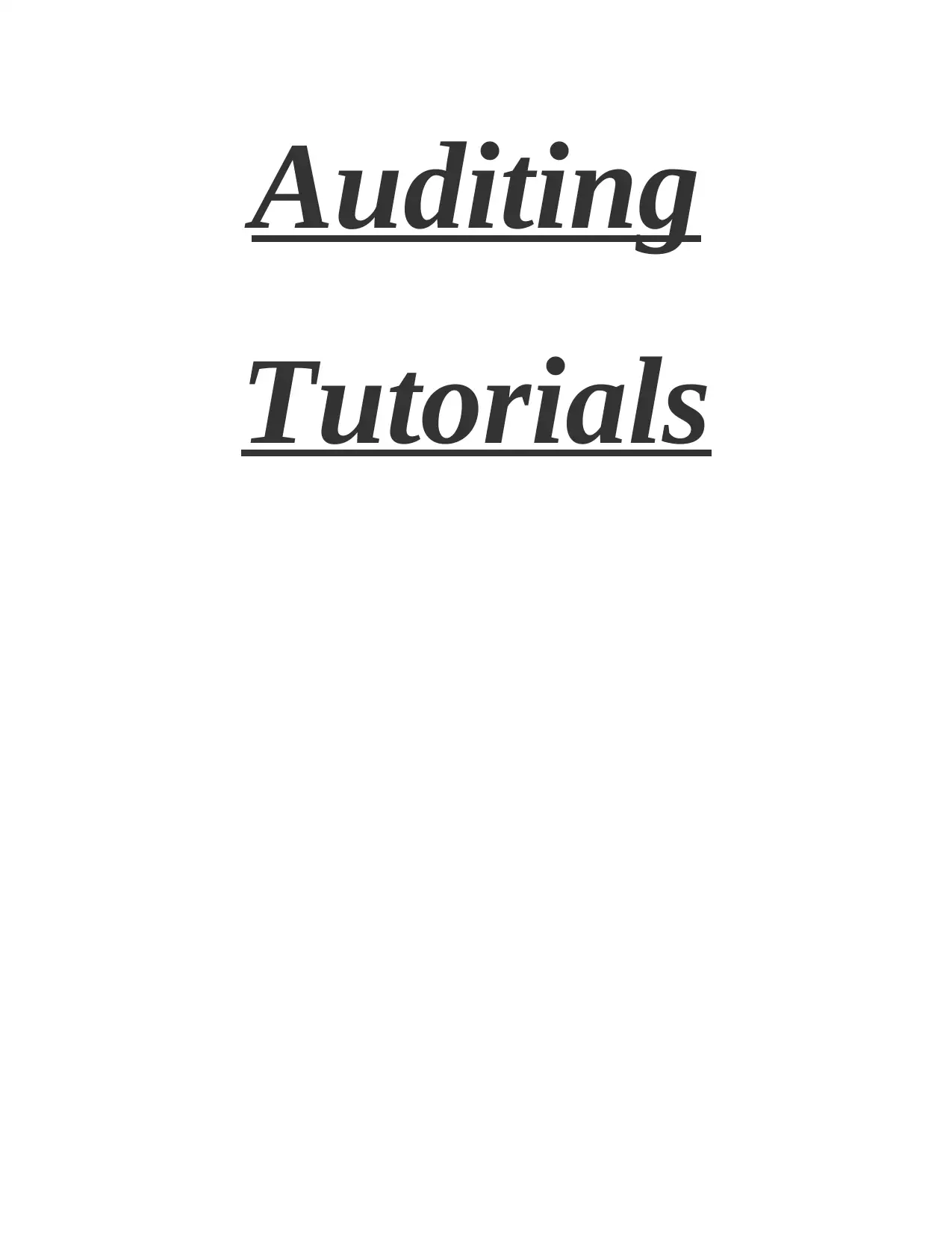
Auditing
Tutorials
Tutorials
Secure Best Marks with AI Grader
Need help grading? Try our AI Grader for instant feedback on your assignments.
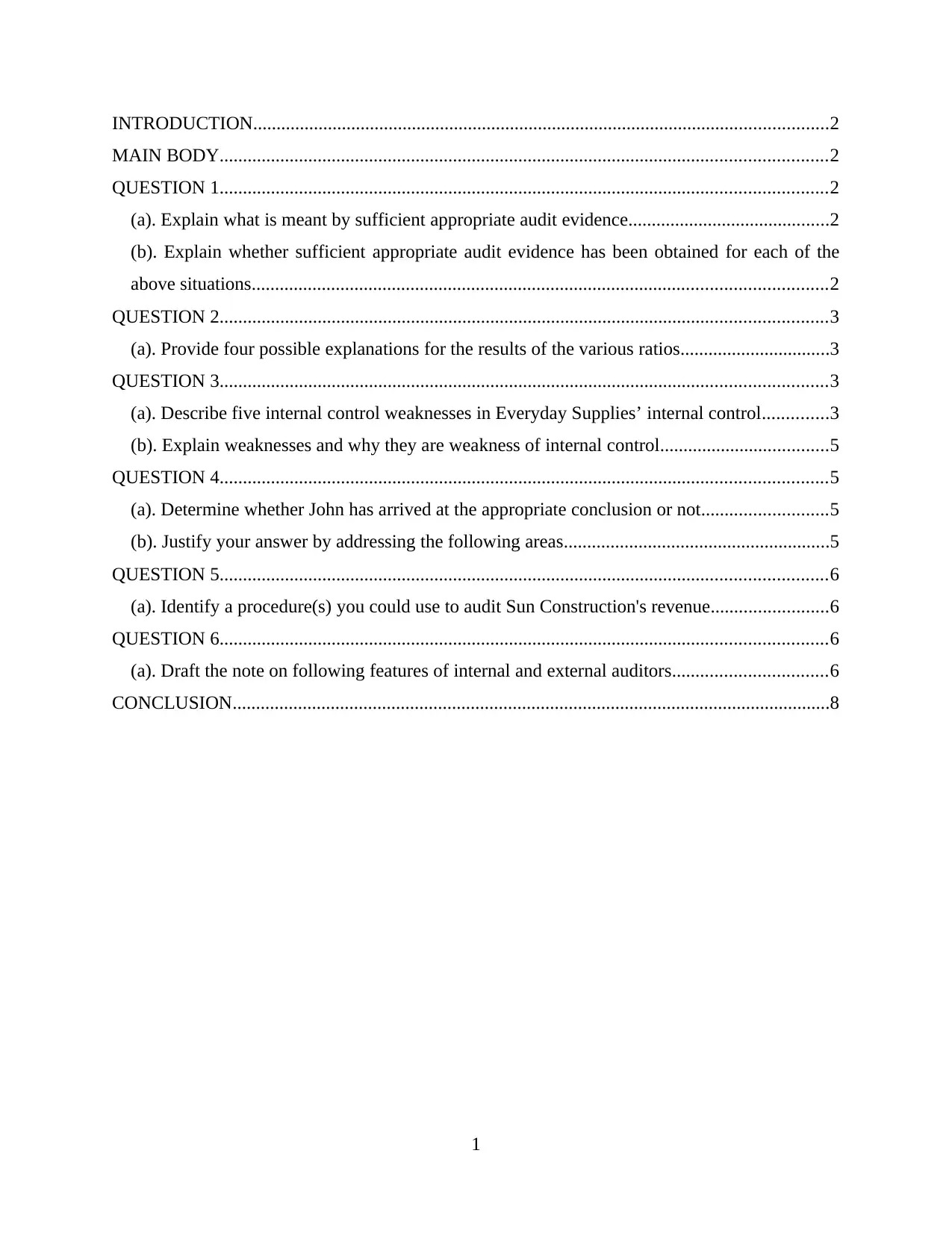
INTRODUCTION...........................................................................................................................2
MAIN BODY..................................................................................................................................2
QUESTION 1..................................................................................................................................2
(a). Explain what is meant by sufficient appropriate audit evidence...........................................2
(b). Explain whether sufficient appropriate audit evidence has been obtained for each of the
above situations...........................................................................................................................2
QUESTION 2..................................................................................................................................3
(a). Provide four possible explanations for the results of the various ratios................................3
QUESTION 3..................................................................................................................................3
(a). Describe five internal control weaknesses in Everyday Supplies’ internal control..............3
(b). Explain weaknesses and why they are weakness of internal control....................................5
QUESTION 4..................................................................................................................................5
(a). Determine whether John has arrived at the appropriate conclusion or not...........................5
(b). Justify your answer by addressing the following areas.........................................................5
QUESTION 5..................................................................................................................................6
(a). Identify a procedure(s) you could use to audit Sun Construction's revenue.........................6
QUESTION 6..................................................................................................................................6
(a). Draft the note on following features of internal and external auditors.................................6
CONCLUSION................................................................................................................................8
1
MAIN BODY..................................................................................................................................2
QUESTION 1..................................................................................................................................2
(a). Explain what is meant by sufficient appropriate audit evidence...........................................2
(b). Explain whether sufficient appropriate audit evidence has been obtained for each of the
above situations...........................................................................................................................2
QUESTION 2..................................................................................................................................3
(a). Provide four possible explanations for the results of the various ratios................................3
QUESTION 3..................................................................................................................................3
(a). Describe five internal control weaknesses in Everyday Supplies’ internal control..............3
(b). Explain weaknesses and why they are weakness of internal control....................................5
QUESTION 4..................................................................................................................................5
(a). Determine whether John has arrived at the appropriate conclusion or not...........................5
(b). Justify your answer by addressing the following areas.........................................................5
QUESTION 5..................................................................................................................................6
(a). Identify a procedure(s) you could use to audit Sun Construction's revenue.........................6
QUESTION 6..................................................................................................................................6
(a). Draft the note on following features of internal and external auditors.................................6
CONCLUSION................................................................................................................................8
1
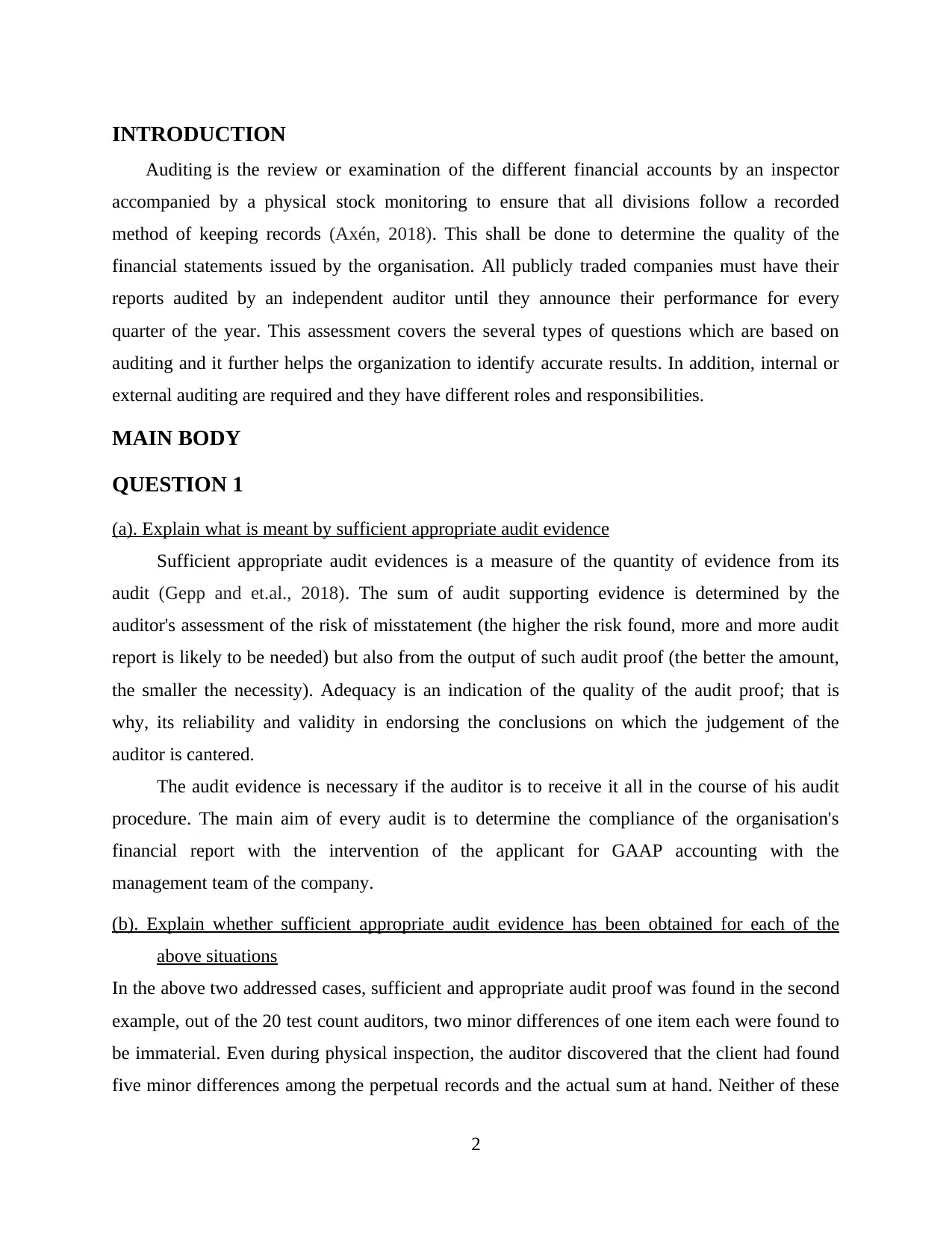
INTRODUCTION
Auditing is the review or examination of the different financial accounts by an inspector
accompanied by a physical stock monitoring to ensure that all divisions follow a recorded
method of keeping records (Axén, 2018). This shall be done to determine the quality of the
financial statements issued by the organisation. All publicly traded companies must have their
reports audited by an independent auditor until they announce their performance for every
quarter of the year. This assessment covers the several types of questions which are based on
auditing and it further helps the organization to identify accurate results. In addition, internal or
external auditing are required and they have different roles and responsibilities.
MAIN BODY
QUESTION 1
(a). Explain what is meant by sufficient appropriate audit evidence
Sufficient appropriate audit evidences is a measure of the quantity of evidence from its
audit (Gepp and et.al., 2018). The sum of audit supporting evidence is determined by the
auditor's assessment of the risk of misstatement (the higher the risk found, more and more audit
report is likely to be needed) but also from the output of such audit proof (the better the amount,
the smaller the necessity). Adequacy is an indication of the quality of the audit proof; that is
why, its reliability and validity in endorsing the conclusions on which the judgement of the
auditor is cantered.
The audit evidence is necessary if the auditor is to receive it all in the course of his audit
procedure. The main aim of every audit is to determine the compliance of the organisation's
financial report with the intervention of the applicant for GAAP accounting with the
management team of the company.
(b). Explain whether sufficient appropriate audit evidence has been obtained for each of the
above situations
In the above two addressed cases, sufficient and appropriate audit proof was found in the second
example, out of the 20 test count auditors, two minor differences of one item each were found to
be immaterial. Even during physical inspection, the auditor discovered that the client had found
five minor differences among the perpetual records and the actual sum at hand. Neither of these
2
Auditing is the review or examination of the different financial accounts by an inspector
accompanied by a physical stock monitoring to ensure that all divisions follow a recorded
method of keeping records (Axén, 2018). This shall be done to determine the quality of the
financial statements issued by the organisation. All publicly traded companies must have their
reports audited by an independent auditor until they announce their performance for every
quarter of the year. This assessment covers the several types of questions which are based on
auditing and it further helps the organization to identify accurate results. In addition, internal or
external auditing are required and they have different roles and responsibilities.
MAIN BODY
QUESTION 1
(a). Explain what is meant by sufficient appropriate audit evidence
Sufficient appropriate audit evidences is a measure of the quantity of evidence from its
audit (Gepp and et.al., 2018). The sum of audit supporting evidence is determined by the
auditor's assessment of the risk of misstatement (the higher the risk found, more and more audit
report is likely to be needed) but also from the output of such audit proof (the better the amount,
the smaller the necessity). Adequacy is an indication of the quality of the audit proof; that is
why, its reliability and validity in endorsing the conclusions on which the judgement of the
auditor is cantered.
The audit evidence is necessary if the auditor is to receive it all in the course of his audit
procedure. The main aim of every audit is to determine the compliance of the organisation's
financial report with the intervention of the applicant for GAAP accounting with the
management team of the company.
(b). Explain whether sufficient appropriate audit evidence has been obtained for each of the
above situations
In the above two addressed cases, sufficient and appropriate audit proof was found in the second
example, out of the 20 test count auditors, two minor differences of one item each were found to
be immaterial. Even during physical inspection, the auditor discovered that the client had found
five minor differences among the perpetual records and the actual sum at hand. Neither of these
2
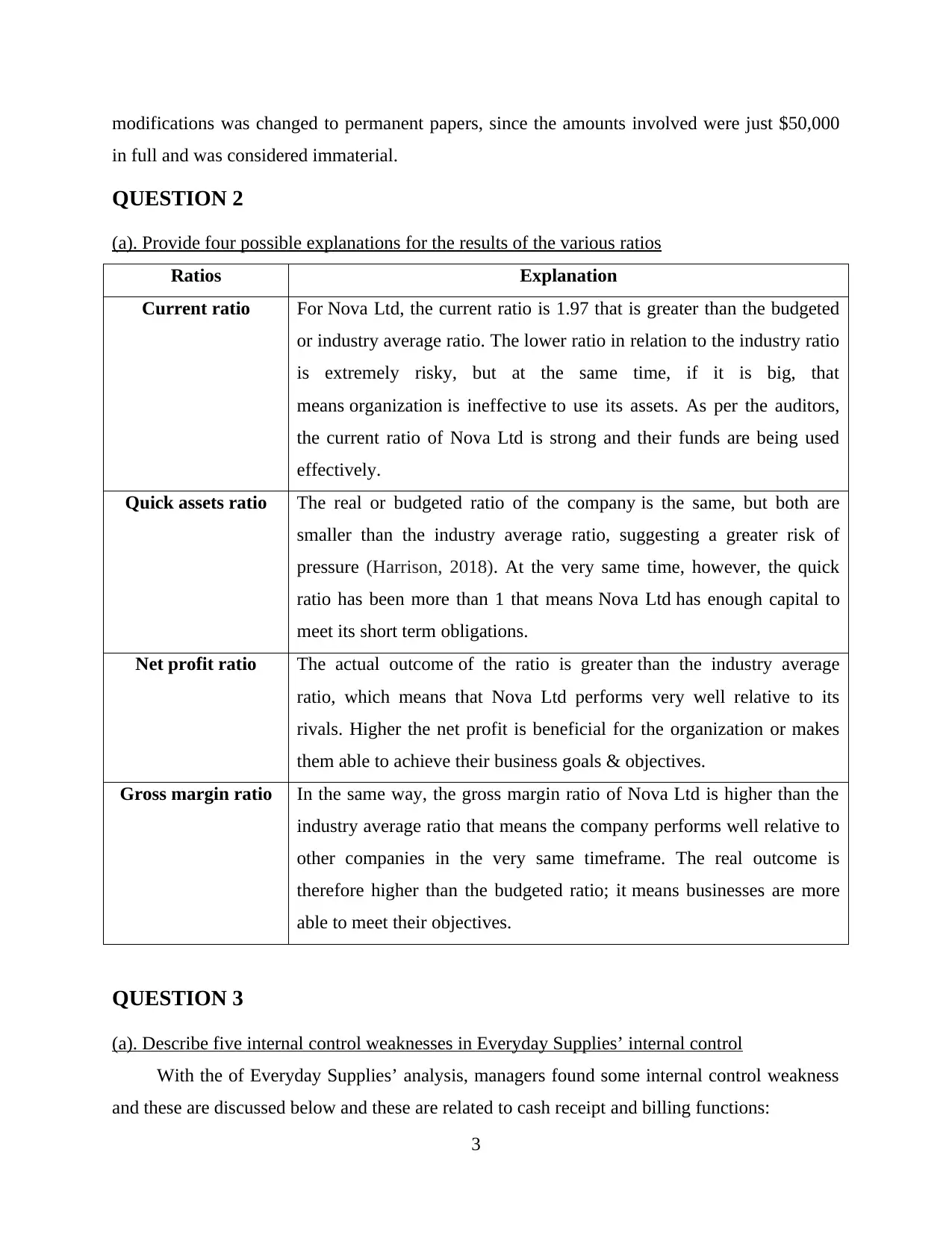
modifications was changed to permanent papers, since the amounts involved were just $50,000
in full and was considered immaterial.
QUESTION 2
(a). Provide four possible explanations for the results of the various ratios
Ratios Explanation
Current ratio For Nova Ltd, the current ratio is 1.97 that is greater than the budgeted
or industry average ratio. The lower ratio in relation to the industry ratio
is extremely risky, but at the same time, if it is big, that
means organization is ineffective to use its assets. As per the auditors,
the current ratio of Nova Ltd is strong and their funds are being used
effectively.
Quick assets ratio The real or budgeted ratio of the company is the same, but both are
smaller than the industry average ratio, suggesting a greater risk of
pressure (Harrison, 2018). At the very same time, however, the quick
ratio has been more than 1 that means Nova Ltd has enough capital to
meet its short term obligations.
Net profit ratio The actual outcome of the ratio is greater than the industry average
ratio, which means that Nova Ltd performs very well relative to its
rivals. Higher the net profit is beneficial for the organization or makes
them able to achieve their business goals & objectives.
Gross margin ratio In the same way, the gross margin ratio of Nova Ltd is higher than the
industry average ratio that means the company performs well relative to
other companies in the very same timeframe. The real outcome is
therefore higher than the budgeted ratio; it means businesses are more
able to meet their objectives.
QUESTION 3
(a). Describe five internal control weaknesses in Everyday Supplies’ internal control
With the of Everyday Supplies’ analysis, managers found some internal control weakness
and these are discussed below and these are related to cash receipt and billing functions:
3
in full and was considered immaterial.
QUESTION 2
(a). Provide four possible explanations for the results of the various ratios
Ratios Explanation
Current ratio For Nova Ltd, the current ratio is 1.97 that is greater than the budgeted
or industry average ratio. The lower ratio in relation to the industry ratio
is extremely risky, but at the same time, if it is big, that
means organization is ineffective to use its assets. As per the auditors,
the current ratio of Nova Ltd is strong and their funds are being used
effectively.
Quick assets ratio The real or budgeted ratio of the company is the same, but both are
smaller than the industry average ratio, suggesting a greater risk of
pressure (Harrison, 2018). At the very same time, however, the quick
ratio has been more than 1 that means Nova Ltd has enough capital to
meet its short term obligations.
Net profit ratio The actual outcome of the ratio is greater than the industry average
ratio, which means that Nova Ltd performs very well relative to its
rivals. Higher the net profit is beneficial for the organization or makes
them able to achieve their business goals & objectives.
Gross margin ratio In the same way, the gross margin ratio of Nova Ltd is higher than the
industry average ratio that means the company performs well relative to
other companies in the very same timeframe. The real outcome is
therefore higher than the budgeted ratio; it means businesses are more
able to meet their objectives.
QUESTION 3
(a). Describe five internal control weaknesses in Everyday Supplies’ internal control
With the of Everyday Supplies’ analysis, managers found some internal control weakness
and these are discussed below and these are related to cash receipt and billing functions:
3
Secure Best Marks with AI Grader
Need help grading? Try our AI Grader for instant feedback on your assignments.
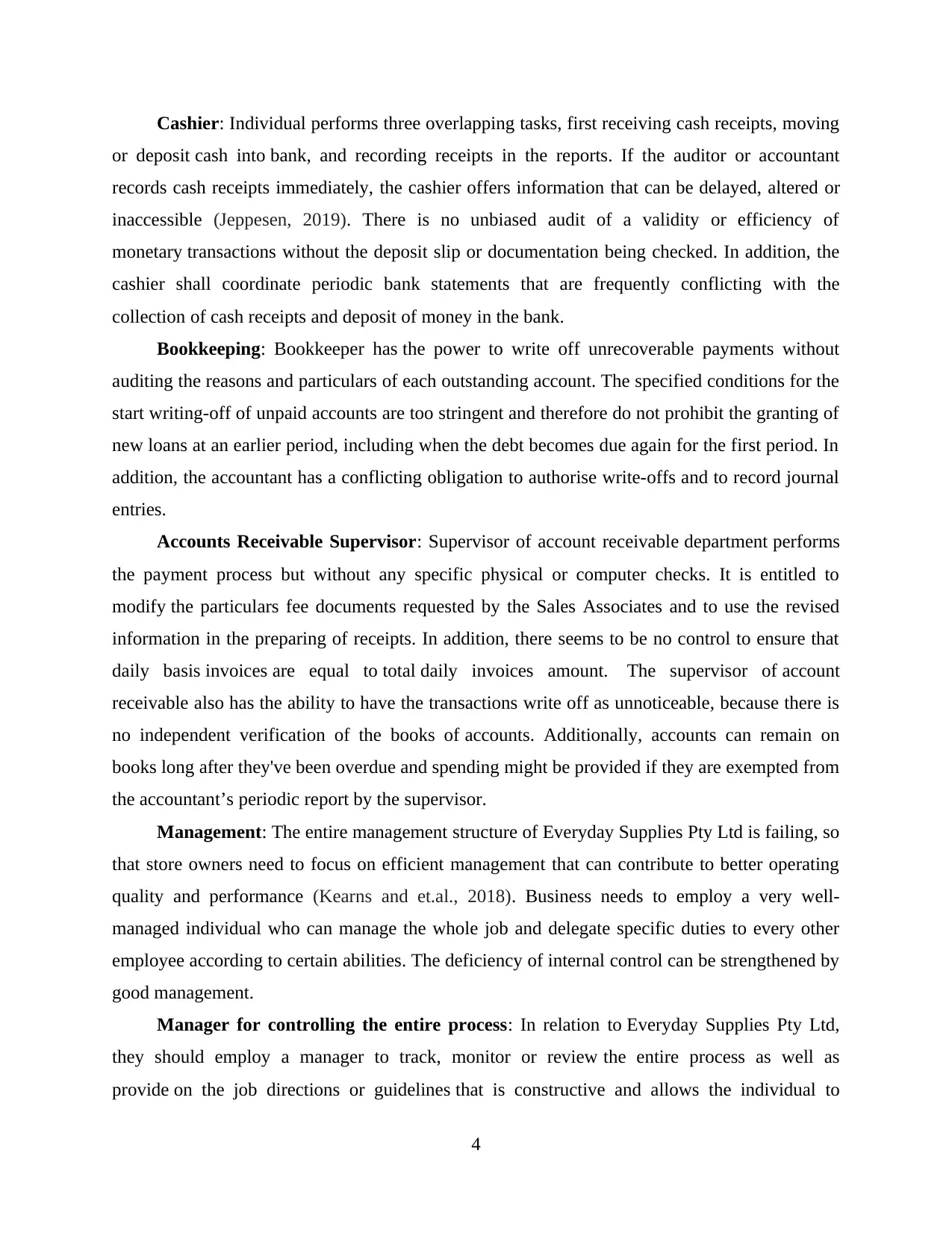
Cashier: Individual performs three overlapping tasks, first receiving cash receipts, moving
or deposit cash into bank, and recording receipts in the reports. If the auditor or accountant
records cash receipts immediately, the cashier offers information that can be delayed, altered or
inaccessible (Jeppesen, 2019). There is no unbiased audit of a validity or efficiency of
monetary transactions without the deposit slip or documentation being checked. In addition, the
cashier shall coordinate periodic bank statements that are frequently conflicting with the
collection of cash receipts and deposit of money in the bank.
Bookkeeping: Bookkeeper has the power to write off unrecoverable payments without
auditing the reasons and particulars of each outstanding account. The specified conditions for the
start writing-off of unpaid accounts are too stringent and therefore do not prohibit the granting of
new loans at an earlier period, including when the debt becomes due again for the first period. In
addition, the accountant has a conflicting obligation to authorise write-offs and to record journal
entries.
Accounts Receivable Supervisor: Supervisor of account receivable department performs
the payment process but without any specific physical or computer checks. It is entitled to
modify the particulars fee documents requested by the Sales Associates and to use the revised
information in the preparing of receipts. In addition, there seems to be no control to ensure that
daily basis invoices are equal to total daily invoices amount. The supervisor of account
receivable also has the ability to have the transactions write off as unnoticeable, because there is
no independent verification of the books of accounts. Additionally, accounts can remain on
books long after they've been overdue and spending might be provided if they are exempted from
the accountant’s periodic report by the supervisor.
Management: The entire management structure of Everyday Supplies Pty Ltd is failing, so
that store owners need to focus on efficient management that can contribute to better operating
quality and performance (Kearns and et.al., 2018). Business needs to employ a very well-
managed individual who can manage the whole job and delegate specific duties to every other
employee according to certain abilities. The deficiency of internal control can be strengthened by
good management.
Manager for controlling the entire process: In relation to Everyday Supplies Pty Ltd,
they should employ a manager to track, monitor or review the entire process as well as
provide on the job directions or guidelines that is constructive and allows the individual to
4
or deposit cash into bank, and recording receipts in the reports. If the auditor or accountant
records cash receipts immediately, the cashier offers information that can be delayed, altered or
inaccessible (Jeppesen, 2019). There is no unbiased audit of a validity or efficiency of
monetary transactions without the deposit slip or documentation being checked. In addition, the
cashier shall coordinate periodic bank statements that are frequently conflicting with the
collection of cash receipts and deposit of money in the bank.
Bookkeeping: Bookkeeper has the power to write off unrecoverable payments without
auditing the reasons and particulars of each outstanding account. The specified conditions for the
start writing-off of unpaid accounts are too stringent and therefore do not prohibit the granting of
new loans at an earlier period, including when the debt becomes due again for the first period. In
addition, the accountant has a conflicting obligation to authorise write-offs and to record journal
entries.
Accounts Receivable Supervisor: Supervisor of account receivable department performs
the payment process but without any specific physical or computer checks. It is entitled to
modify the particulars fee documents requested by the Sales Associates and to use the revised
information in the preparing of receipts. In addition, there seems to be no control to ensure that
daily basis invoices are equal to total daily invoices amount. The supervisor of account
receivable also has the ability to have the transactions write off as unnoticeable, because there is
no independent verification of the books of accounts. Additionally, accounts can remain on
books long after they've been overdue and spending might be provided if they are exempted from
the accountant’s periodic report by the supervisor.
Management: The entire management structure of Everyday Supplies Pty Ltd is failing, so
that store owners need to focus on efficient management that can contribute to better operating
quality and performance (Kearns and et.al., 2018). Business needs to employ a very well-
managed individual who can manage the whole job and delegate specific duties to every other
employee according to certain abilities. The deficiency of internal control can be strengthened by
good management.
Manager for controlling the entire process: In relation to Everyday Supplies Pty Ltd,
they should employ a manager to track, monitor or review the entire process as well as
provide on the job directions or guidelines that is constructive and allows the individual to
4
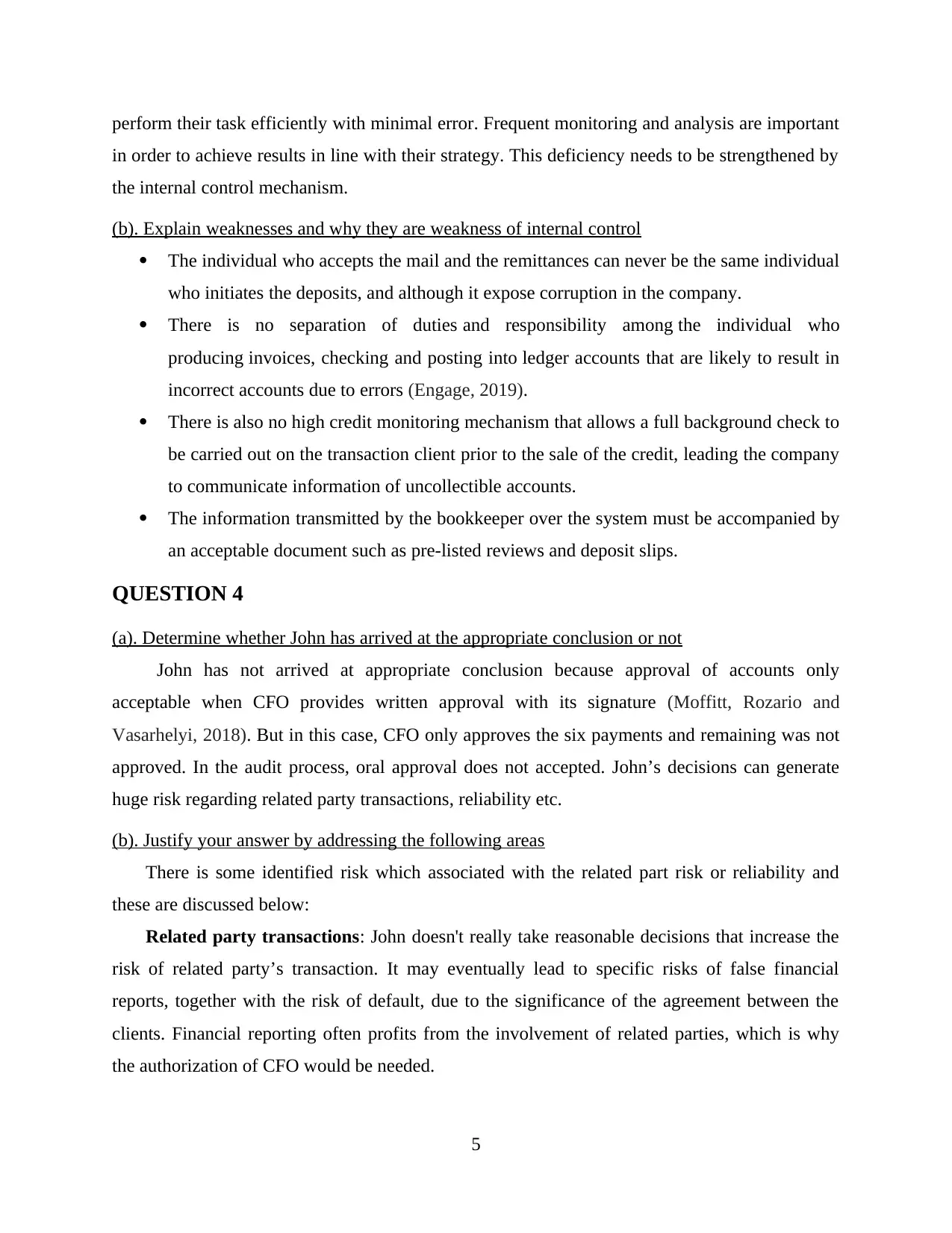
perform their task efficiently with minimal error. Frequent monitoring and analysis are important
in order to achieve results in line with their strategy. This deficiency needs to be strengthened by
the internal control mechanism.
(b). Explain weaknesses and why they are weakness of internal control
The individual who accepts the mail and the remittances can never be the same individual
who initiates the deposits, and although it expose corruption in the company.
There is no separation of duties and responsibility among the individual who
producing invoices, checking and posting into ledger accounts that are likely to result in
incorrect accounts due to errors (Engage, 2019).
There is also no high credit monitoring mechanism that allows a full background check to
be carried out on the transaction client prior to the sale of the credit, leading the company
to communicate information of uncollectible accounts.
The information transmitted by the bookkeeper over the system must be accompanied by
an acceptable document such as pre-listed reviews and deposit slips.
QUESTION 4
(a). Determine whether John has arrived at the appropriate conclusion or not
John has not arrived at appropriate conclusion because approval of accounts only
acceptable when CFO provides written approval with its signature (Moffitt, Rozario and
Vasarhelyi, 2018). But in this case, CFO only approves the six payments and remaining was not
approved. In the audit process, oral approval does not accepted. John’s decisions can generate
huge risk regarding related party transactions, reliability etc.
(b). Justify your answer by addressing the following areas
There is some identified risk which associated with the related part risk or reliability and
these are discussed below:
Related party transactions: John doesn't really take reasonable decisions that increase the
risk of related party’s transaction. It may eventually lead to specific risks of false financial
reports, together with the risk of default, due to the significance of the agreement between the
clients. Financial reporting often profits from the involvement of related parties, which is why
the authorization of CFO would be needed.
5
in order to achieve results in line with their strategy. This deficiency needs to be strengthened by
the internal control mechanism.
(b). Explain weaknesses and why they are weakness of internal control
The individual who accepts the mail and the remittances can never be the same individual
who initiates the deposits, and although it expose corruption in the company.
There is no separation of duties and responsibility among the individual who
producing invoices, checking and posting into ledger accounts that are likely to result in
incorrect accounts due to errors (Engage, 2019).
There is also no high credit monitoring mechanism that allows a full background check to
be carried out on the transaction client prior to the sale of the credit, leading the company
to communicate information of uncollectible accounts.
The information transmitted by the bookkeeper over the system must be accompanied by
an acceptable document such as pre-listed reviews and deposit slips.
QUESTION 4
(a). Determine whether John has arrived at the appropriate conclusion or not
John has not arrived at appropriate conclusion because approval of accounts only
acceptable when CFO provides written approval with its signature (Moffitt, Rozario and
Vasarhelyi, 2018). But in this case, CFO only approves the six payments and remaining was not
approved. In the audit process, oral approval does not accepted. John’s decisions can generate
huge risk regarding related party transactions, reliability etc.
(b). Justify your answer by addressing the following areas
There is some identified risk which associated with the related part risk or reliability and
these are discussed below:
Related party transactions: John doesn't really take reasonable decisions that increase the
risk of related party’s transaction. It may eventually lead to specific risks of false financial
reports, together with the risk of default, due to the significance of the agreement between the
clients. Financial reporting often profits from the involvement of related parties, which is why
the authorization of CFO would be needed.
5
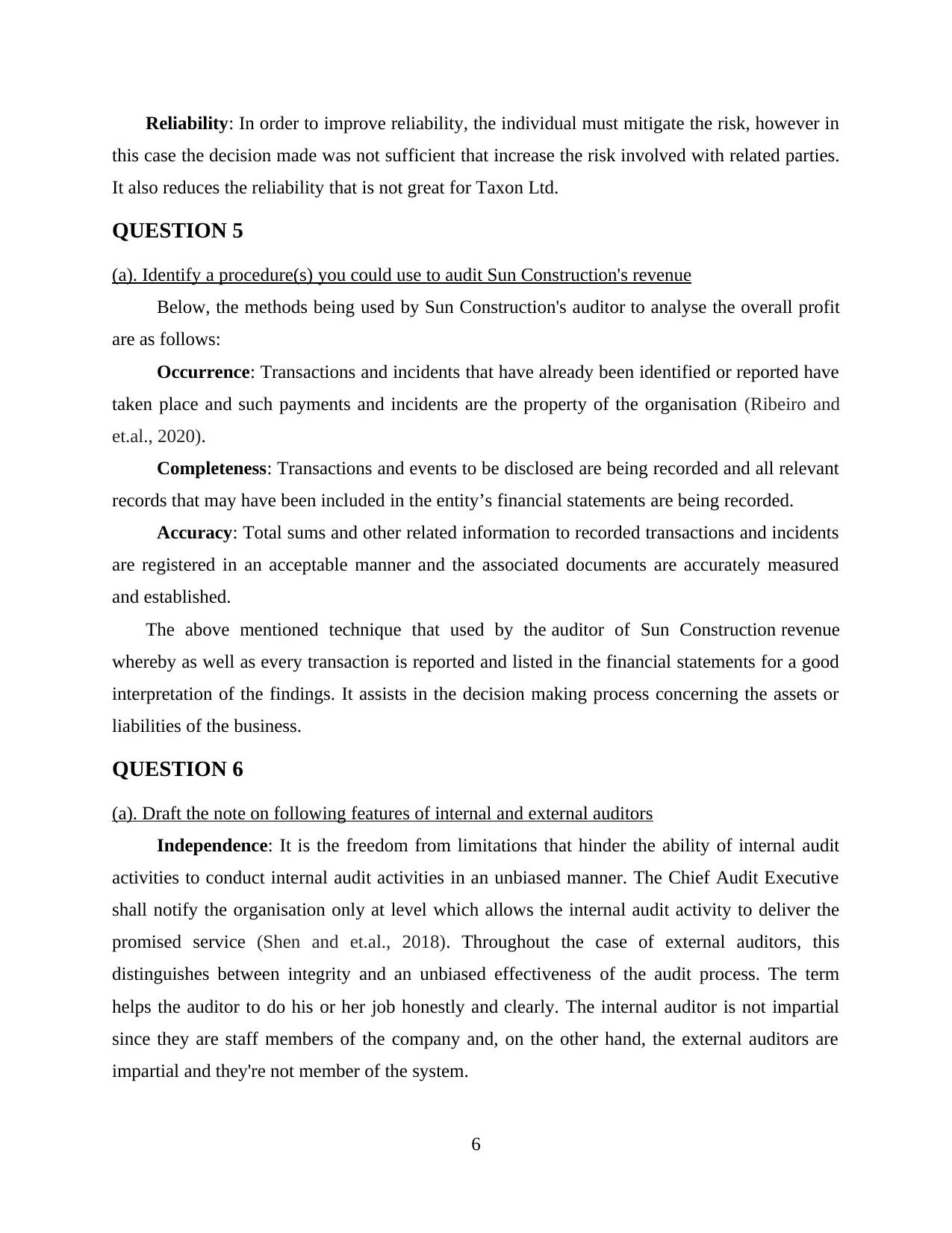
Reliability: In order to improve reliability, the individual must mitigate the risk, however in
this case the decision made was not sufficient that increase the risk involved with related parties.
It also reduces the reliability that is not great for Taxon Ltd.
QUESTION 5
(a). Identify a procedure(s) you could use to audit Sun Construction's revenue
Below, the methods being used by Sun Construction's auditor to analyse the overall profit
are as follows:
Occurrence: Transactions and incidents that have already been identified or reported have
taken place and such payments and incidents are the property of the organisation (Ribeiro and
et.al., 2020).
Completeness: Transactions and events to be disclosed are being recorded and all relevant
records that may have been included in the entity’s financial statements are being recorded.
Accuracy: Total sums and other related information to recorded transactions and incidents
are registered in an acceptable manner and the associated documents are accurately measured
and established.
The above mentioned technique that used by the auditor of Sun Construction revenue
whereby as well as every transaction is reported and listed in the financial statements for a good
interpretation of the findings. It assists in the decision making process concerning the assets or
liabilities of the business.
QUESTION 6
(a). Draft the note on following features of internal and external auditors
Independence: It is the freedom from limitations that hinder the ability of internal audit
activities to conduct internal audit activities in an unbiased manner. The Chief Audit Executive
shall notify the organisation only at level which allows the internal audit activity to deliver the
promised service (Shen and et.al., 2018). Throughout the case of external auditors, this
distinguishes between integrity and an unbiased effectiveness of the audit process. The term
helps the auditor to do his or her job honestly and clearly. The internal auditor is not impartial
since they are staff members of the company and, on the other hand, the external auditors are
impartial and they're not member of the system.
6
this case the decision made was not sufficient that increase the risk involved with related parties.
It also reduces the reliability that is not great for Taxon Ltd.
QUESTION 5
(a). Identify a procedure(s) you could use to audit Sun Construction's revenue
Below, the methods being used by Sun Construction's auditor to analyse the overall profit
are as follows:
Occurrence: Transactions and incidents that have already been identified or reported have
taken place and such payments and incidents are the property of the organisation (Ribeiro and
et.al., 2020).
Completeness: Transactions and events to be disclosed are being recorded and all relevant
records that may have been included in the entity’s financial statements are being recorded.
Accuracy: Total sums and other related information to recorded transactions and incidents
are registered in an acceptable manner and the associated documents are accurately measured
and established.
The above mentioned technique that used by the auditor of Sun Construction revenue
whereby as well as every transaction is reported and listed in the financial statements for a good
interpretation of the findings. It assists in the decision making process concerning the assets or
liabilities of the business.
QUESTION 6
(a). Draft the note on following features of internal and external auditors
Independence: It is the freedom from limitations that hinder the ability of internal audit
activities to conduct internal audit activities in an unbiased manner. The Chief Audit Executive
shall notify the organisation only at level which allows the internal audit activity to deliver the
promised service (Shen and et.al., 2018). Throughout the case of external auditors, this
distinguishes between integrity and an unbiased effectiveness of the audit process. The term
helps the auditor to do his or her job honestly and clearly. The internal auditor is not impartial
since they are staff members of the company and, on the other hand, the external auditors are
impartial and they're not member of the system.
6
Paraphrase This Document
Need a fresh take? Get an instant paraphrase of this document with our AI Paraphraser
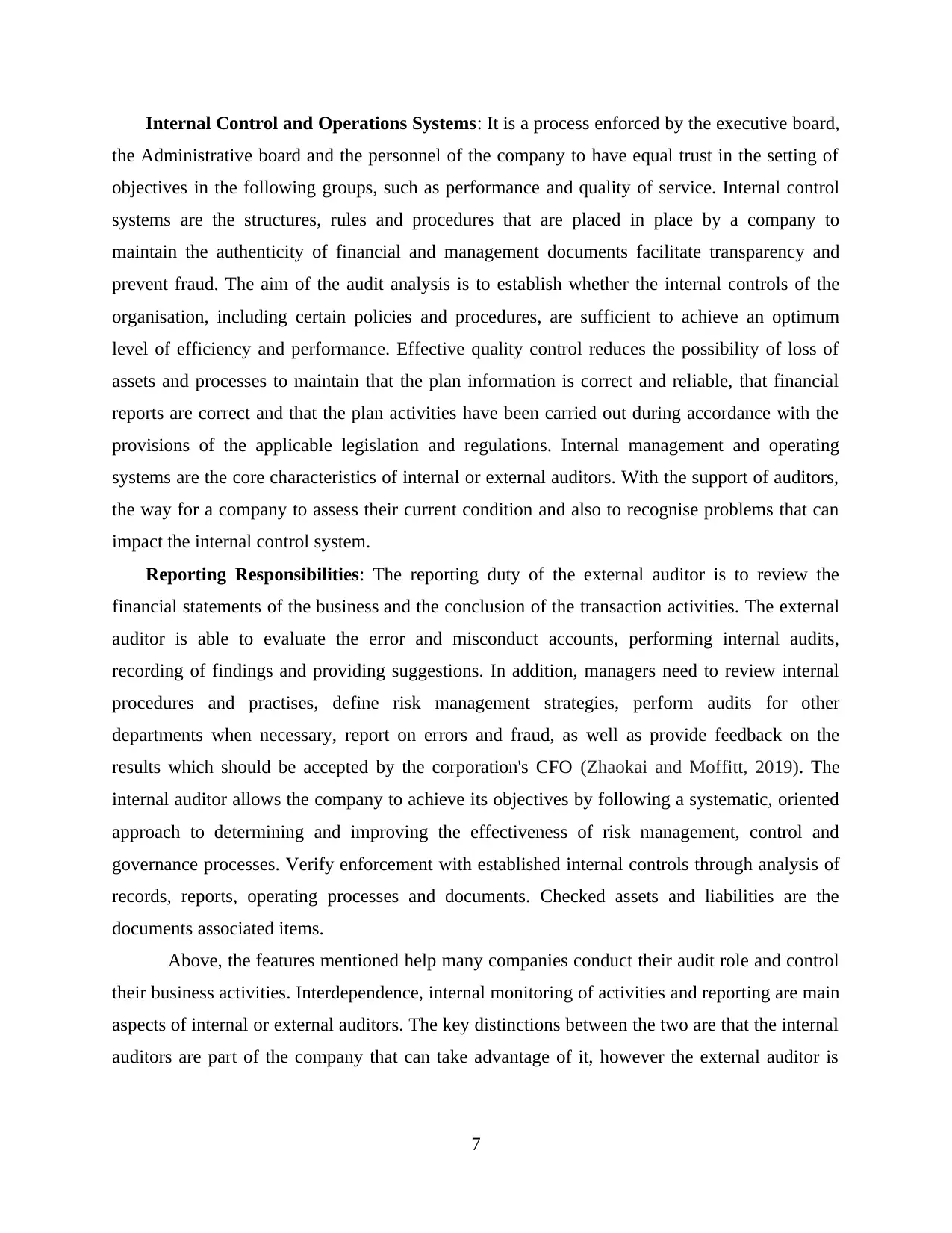
Internal Control and Operations Systems: It is a process enforced by the executive board,
the Administrative board and the personnel of the company to have equal trust in the setting of
objectives in the following groups, such as performance and quality of service. Internal control
systems are the structures, rules and procedures that are placed in place by a company to
maintain the authenticity of financial and management documents facilitate transparency and
prevent fraud. The aim of the audit analysis is to establish whether the internal controls of the
organisation, including certain policies and procedures, are sufficient to achieve an optimum
level of efficiency and performance. Effective quality control reduces the possibility of loss of
assets and processes to maintain that the plan information is correct and reliable, that financial
reports are correct and that the plan activities have been carried out during accordance with the
provisions of the applicable legislation and regulations. Internal management and operating
systems are the core characteristics of internal or external auditors. With the support of auditors,
the way for a company to assess their current condition and also to recognise problems that can
impact the internal control system.
Reporting Responsibilities: The reporting duty of the external auditor is to review the
financial statements of the business and the conclusion of the transaction activities. The external
auditor is able to evaluate the error and misconduct accounts, performing internal audits,
recording of findings and providing suggestions. In addition, managers need to review internal
procedures and practises, define risk management strategies, perform audits for other
departments when necessary, report on errors and fraud, as well as provide feedback on the
results which should be accepted by the corporation's CFO (Zhaokai and Moffitt, 2019). The
internal auditor allows the company to achieve its objectives by following a systematic, oriented
approach to determining and improving the effectiveness of risk management, control and
governance processes. Verify enforcement with established internal controls through analysis of
records, reports, operating processes and documents. Checked assets and liabilities are the
documents associated items.
Above, the features mentioned help many companies conduct their audit role and control
their business activities. Interdependence, internal monitoring of activities and reporting are main
aspects of internal or external auditors. The key distinctions between the two are that the internal
auditors are part of the company that can take advantage of it, however the external auditor is
7
the Administrative board and the personnel of the company to have equal trust in the setting of
objectives in the following groups, such as performance and quality of service. Internal control
systems are the structures, rules and procedures that are placed in place by a company to
maintain the authenticity of financial and management documents facilitate transparency and
prevent fraud. The aim of the audit analysis is to establish whether the internal controls of the
organisation, including certain policies and procedures, are sufficient to achieve an optimum
level of efficiency and performance. Effective quality control reduces the possibility of loss of
assets and processes to maintain that the plan information is correct and reliable, that financial
reports are correct and that the plan activities have been carried out during accordance with the
provisions of the applicable legislation and regulations. Internal management and operating
systems are the core characteristics of internal or external auditors. With the support of auditors,
the way for a company to assess their current condition and also to recognise problems that can
impact the internal control system.
Reporting Responsibilities: The reporting duty of the external auditor is to review the
financial statements of the business and the conclusion of the transaction activities. The external
auditor is able to evaluate the error and misconduct accounts, performing internal audits,
recording of findings and providing suggestions. In addition, managers need to review internal
procedures and practises, define risk management strategies, perform audits for other
departments when necessary, report on errors and fraud, as well as provide feedback on the
results which should be accepted by the corporation's CFO (Zhaokai and Moffitt, 2019). The
internal auditor allows the company to achieve its objectives by following a systematic, oriented
approach to determining and improving the effectiveness of risk management, control and
governance processes. Verify enforcement with established internal controls through analysis of
records, reports, operating processes and documents. Checked assets and liabilities are the
documents associated items.
Above, the features mentioned help many companies conduct their audit role and control
their business activities. Interdependence, internal monitoring of activities and reporting are main
aspects of internal or external auditors. The key distinctions between the two are that the internal
auditors are part of the company that can take advantage of it, however the external auditor is
7
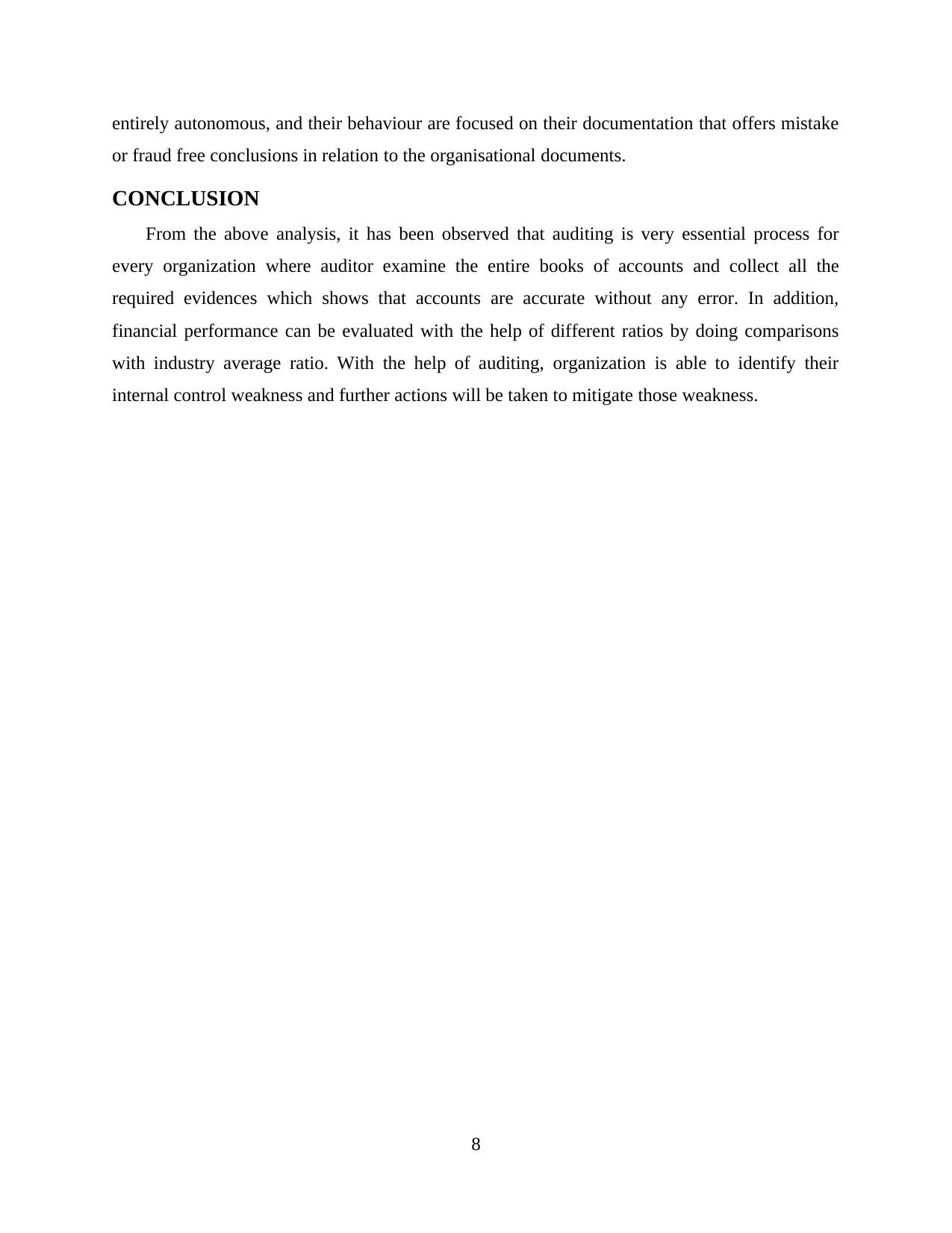
entirely autonomous, and their behaviour are focused on their documentation that offers mistake
or fraud free conclusions in relation to the organisational documents.
CONCLUSION
From the above analysis, it has been observed that auditing is very essential process for
every organization where auditor examine the entire books of accounts and collect all the
required evidences which shows that accounts are accurate without any error. In addition,
financial performance can be evaluated with the help of different ratios by doing comparisons
with industry average ratio. With the help of auditing, organization is able to identify their
internal control weakness and further actions will be taken to mitigate those weakness.
8
or fraud free conclusions in relation to the organisational documents.
CONCLUSION
From the above analysis, it has been observed that auditing is very essential process for
every organization where auditor examine the entire books of accounts and collect all the
required evidences which shows that accounts are accurate without any error. In addition,
financial performance can be evaluated with the help of different ratios by doing comparisons
with industry average ratio. With the help of auditing, organization is able to identify their
internal control weakness and further actions will be taken to mitigate those weakness.
8
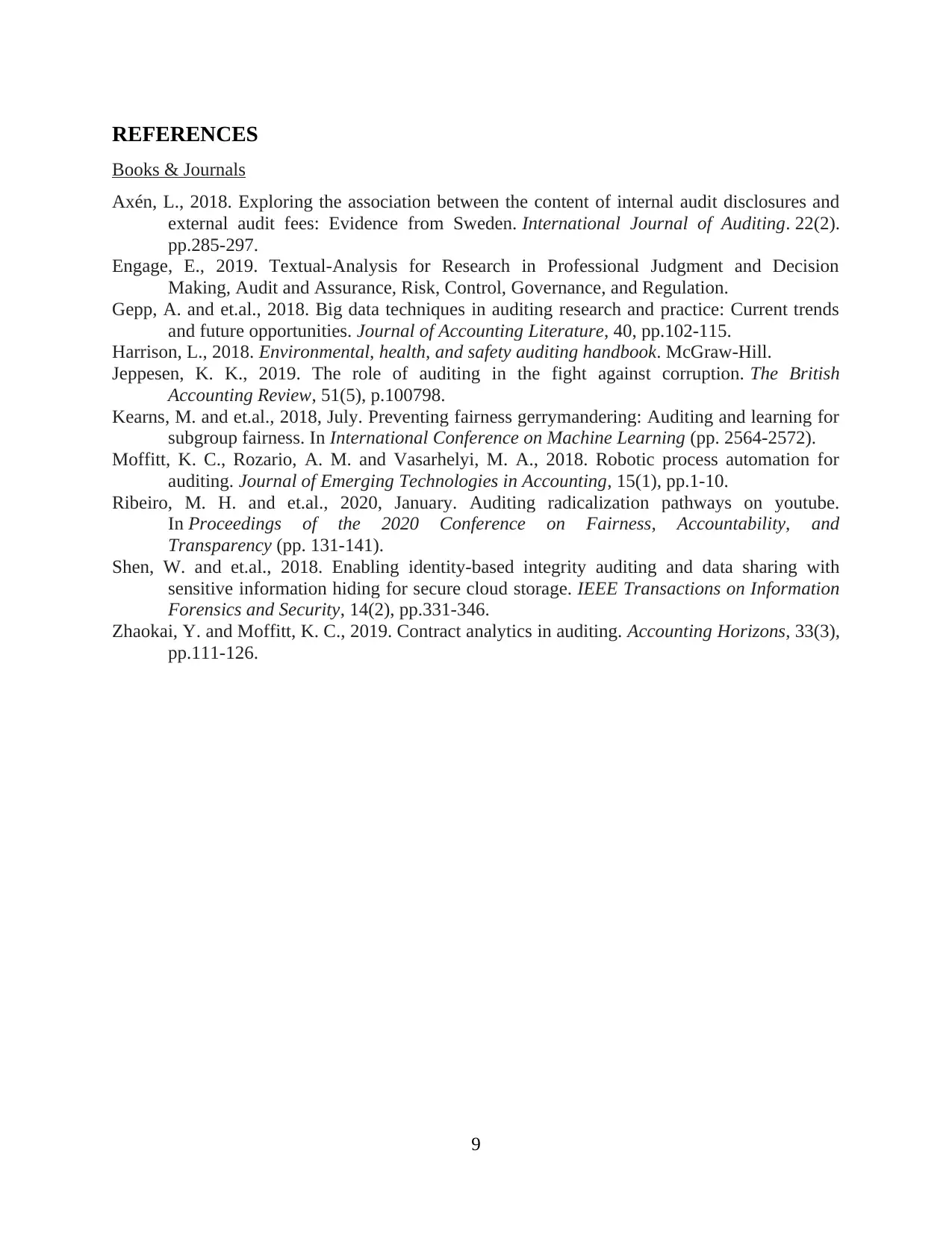
REFERENCES
Books & Journals
Axén, L., 2018. Exploring the association between the content of internal audit disclosures and
external audit fees: Evidence from Sweden. International Journal of Auditing. 22(2).
pp.285-297.
Engage, E., 2019. Textual-Analysis for Research in Professional Judgment and Decision
Making, Audit and Assurance, Risk, Control, Governance, and Regulation.
Gepp, A. and et.al., 2018. Big data techniques in auditing research and practice: Current trends
and future opportunities. Journal of Accounting Literature, 40, pp.102-115.
Harrison, L., 2018. Environmental, health, and safety auditing handbook. McGraw-Hill.
Jeppesen, K. K., 2019. The role of auditing in the fight against corruption. The British
Accounting Review, 51(5), p.100798.
Kearns, M. and et.al., 2018, July. Preventing fairness gerrymandering: Auditing and learning for
subgroup fairness. In International Conference on Machine Learning (pp. 2564-2572).
Moffitt, K. C., Rozario, A. M. and Vasarhelyi, M. A., 2018. Robotic process automation for
auditing. Journal of Emerging Technologies in Accounting, 15(1), pp.1-10.
Ribeiro, M. H. and et.al., 2020, January. Auditing radicalization pathways on youtube.
In Proceedings of the 2020 Conference on Fairness, Accountability, and
Transparency (pp. 131-141).
Shen, W. and et.al., 2018. Enabling identity-based integrity auditing and data sharing with
sensitive information hiding for secure cloud storage. IEEE Transactions on Information
Forensics and Security, 14(2), pp.331-346.
Zhaokai, Y. and Moffitt, K. C., 2019. Contract analytics in auditing. Accounting Horizons, 33(3),
pp.111-126.
9
Books & Journals
Axén, L., 2018. Exploring the association between the content of internal audit disclosures and
external audit fees: Evidence from Sweden. International Journal of Auditing. 22(2).
pp.285-297.
Engage, E., 2019. Textual-Analysis for Research in Professional Judgment and Decision
Making, Audit and Assurance, Risk, Control, Governance, and Regulation.
Gepp, A. and et.al., 2018. Big data techniques in auditing research and practice: Current trends
and future opportunities. Journal of Accounting Literature, 40, pp.102-115.
Harrison, L., 2018. Environmental, health, and safety auditing handbook. McGraw-Hill.
Jeppesen, K. K., 2019. The role of auditing in the fight against corruption. The British
Accounting Review, 51(5), p.100798.
Kearns, M. and et.al., 2018, July. Preventing fairness gerrymandering: Auditing and learning for
subgroup fairness. In International Conference on Machine Learning (pp. 2564-2572).
Moffitt, K. C., Rozario, A. M. and Vasarhelyi, M. A., 2018. Robotic process automation for
auditing. Journal of Emerging Technologies in Accounting, 15(1), pp.1-10.
Ribeiro, M. H. and et.al., 2020, January. Auditing radicalization pathways on youtube.
In Proceedings of the 2020 Conference on Fairness, Accountability, and
Transparency (pp. 131-141).
Shen, W. and et.al., 2018. Enabling identity-based integrity auditing and data sharing with
sensitive information hiding for secure cloud storage. IEEE Transactions on Information
Forensics and Security, 14(2), pp.331-346.
Zhaokai, Y. and Moffitt, K. C., 2019. Contract analytics in auditing. Accounting Horizons, 33(3),
pp.111-126.
9
1 out of 10
Related Documents
Your All-in-One AI-Powered Toolkit for Academic Success.
+13062052269
info@desklib.com
Available 24*7 on WhatsApp / Email
![[object Object]](/_next/static/media/star-bottom.7253800d.svg)
Unlock your academic potential
© 2024 | Zucol Services PVT LTD | All rights reserved.





